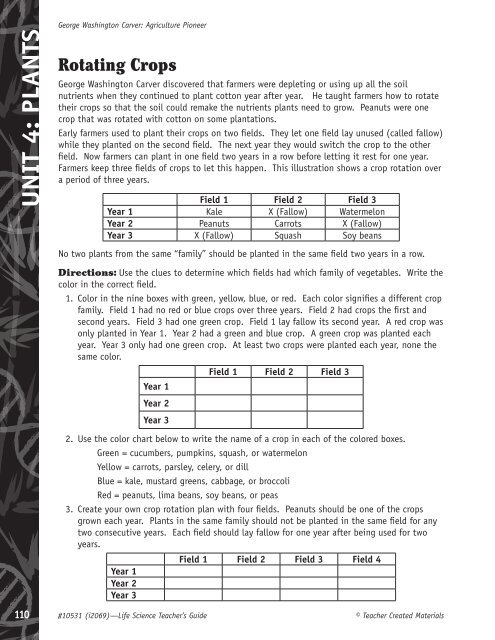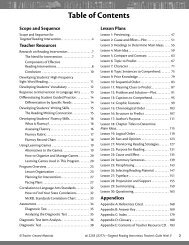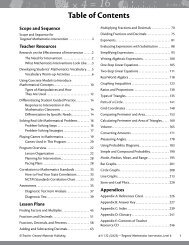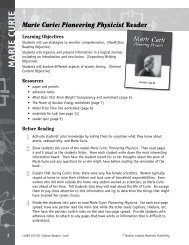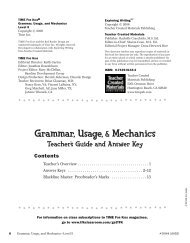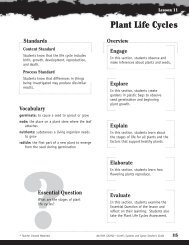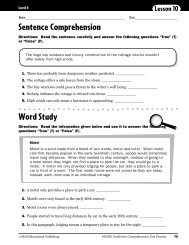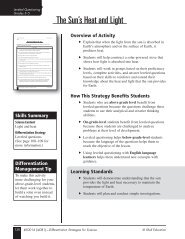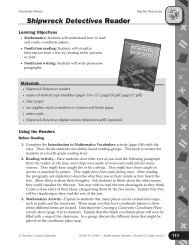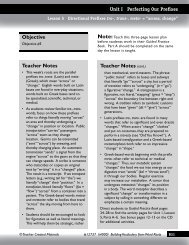George Washington Carver - Teacher Created Materials
George Washington Carver - Teacher Created Materials
George Washington Carver - Teacher Created Materials
Create successful ePaper yourself
Turn your PDF publications into a flip-book with our unique Google optimized e-Paper software.
Unit 4: Plants<br />
<strong>George</strong> <strong>Washington</strong> <strong>Carver</strong>: Agriculture Pioneer<br />
Rotating Crops<br />
<strong>George</strong> <strong>Washington</strong> <strong>Carver</strong> discovered that farmers were depleting or using up all the soil<br />
nutrients when they continued to plant cotton year after year. He taught farmers how to rotate<br />
their crops so that the soil could remake the nutrients plants need to grow. Peanuts were one<br />
crop that was rotated with cotton on some plantations.<br />
Early farmers used to plant their crops on two fields. They let one field lay unused (called fallow)<br />
while they planted on the second field. The next year they would switch the crop to the other<br />
field. Now farmers can plant in one field two years in a row before letting it rest for one year.<br />
Farmers keep three fields of crops to let this happen. This illustration shows a crop rotation over<br />
a period of three years.<br />
Field 1 Field 2 Field 3<br />
Year 1 Kale X (Fallow) Watermelon<br />
Year 2 Peanuts Carrots X (Fallow)<br />
Year 3 X (Fallow) Squash Soy beans<br />
No two plants from the same “family” should be planted in the same field two years in a row.<br />
Directions: Use the clues to determine which fields had which family of vegetables. Write the<br />
color in the correct field.<br />
1. Color in the nine boxes with green, yellow, blue, or red. Each color signifies a different crop<br />
family. Field 1 had no red or blue crops over three years. Field 2 had crops the first and<br />
second years. Field 3 had one green crop. Field 1 lay fallow its second year. A red crop was<br />
only planted in Year 1. Year 2 had a green and blue crop. A green crop was planted each<br />
year. Year 3 only had one green crop. At least two crops were planted each year, none the<br />
same color.<br />
Field 1 Field 2 Field 3<br />
Year 1<br />
Year 2<br />
Year 3<br />
2. Use the color chart below to write the name of a crop in each of the colored boxes.<br />
Green = cucumbers, pumpkins, squash, or watermelon<br />
Yellow = carrots, parsley, celery, or dill<br />
Blue = kale, mustard greens, cabbage, or broccoli<br />
Red = peanuts, lima beans, soy beans, or peas<br />
3. Create your own crop rotation plan with four fields. Peanuts should be one of the crops<br />
grown each year. Plants in the same family should not be planted in the same field for any<br />
two consecutive years. Each field should lay fallow for one year after being used for two<br />
years.<br />
Field 1 Field 2 Field 3 Field 4<br />
Year 1<br />
Year 2<br />
Year 3<br />
110<br />
#10531 (i2069)—Life Science <strong>Teacher</strong>’s Guide © <strong>Teacher</strong> <strong>Created</strong> <strong>Materials</strong>


